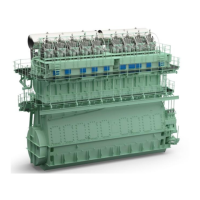Operation4002−1/A1
Winterthur Gas & Diesel Ltd.
12/ 15
5. Communication between WECS-9520 and External
Systems
WECS−9520 gives the data communications that follow to the:
D Propulsion control system
D Alarm and monitoring system (AMS)
D Control panel at local maneuvering stand
D BACKUP control box in the control room.
The standard version of WECS−9520 has the external communications that follow:
D Two redundant data cables to the remote control
D Two redundant data cables to the AMS
D One data cable to the local control panel
D One data cable to the BACKUP control box in control room
D One data cable to a connector at BACKUP control box of the remote control for
connection to a notebook for the service personnel.
For the schematic diagrams, see Fig. 9 and Fig. 1.
Note: The communications between the systems can be different and is related
to the approved system manufacturers (see the related documentation).
5.1 Propulsion control system
The propulsion control system is divided into the subsystems that follow:
D The remote control system (RCS)
D The electronic speed control system
D The safety system
D The telegraph system
Note: The safety system and telegraph system operate independently and are
fully operational if remote control functions become defective.
5.2 Remote Control System
The remote control system (RCS) has the primary functions that follow:
D Start, stop and reverse
D Automatic slow turning
D Auxiliary blower control
D Transfer control
D Speed setting
D Automatic speed setting program
Data about the WECS−9520 status is available in the remote control. The data
includes measured values of sensors, alarm indications, parameter settings and trend
lines (see the documentation of remote control manufacturer).
Engine Control System WECS-9520
2014

